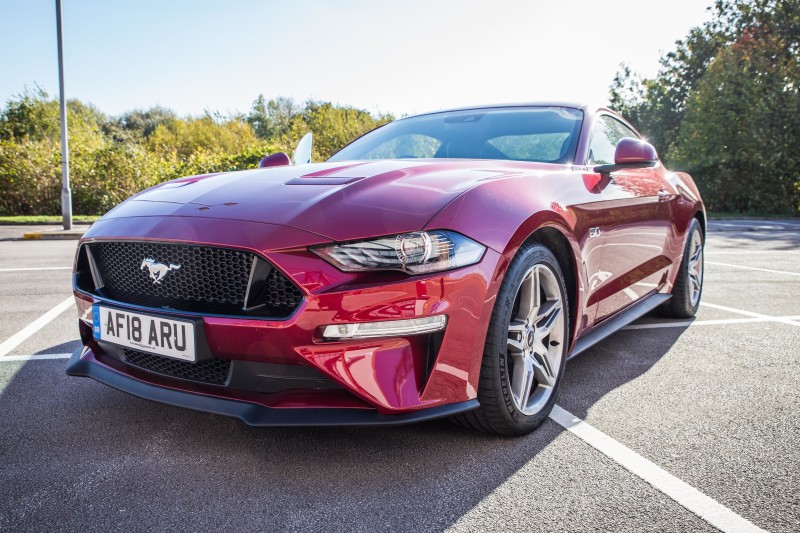IF there was such a thing as wonders of the motoring world - things you simply must witness at some point in your life - driving a manual Mustang with a V8 engine would surely make the shortlist.
Fair enough, it’s a car known for its brutish simplicity and although it can never claim to be the sharpest tool in the box, some people prefer the nature American V8s have over things like a Porsche flat six or a Ferrari V12. Personally I’m not of that train of thought but I understand why others would be as the engines they make are loud, brash and make no apologies for it.
The Mustang has always been the sports car of the people, something incredibly distinctive but one that’s attainable. That’s not the case with many other performance cars and they often remain a dream to most.
There are two engine options on the new Mustang - a 2.3-litre four-cylinder sourced from the impressive Focus RS and this, a 5.0-litre, 444bhp naturally aspirated V8. Having driven the smaller version in the spring, which had Ford’s woeful ten-speed automatic gearbox, this car is an altogether different kettle of fish and makes any case to buy the 2.3 redundant.
Although it looks virtually identical - proud ‘5.0’ badges on its wings, a GT moniker on the boot and a quad-exit exhaust are the only things which are different on the V8 model - a press of the starter button immediately reveals something else. Your ears pick up a hearty, unmistakably V8 rumble - a glorious tone which never fails to bring a child-like grin to your face.
Inside it’s pretty low rent; there’s a lot of leather and plastic but I’m not a fan of its design and the less said about the steering wheel, the better. There’s masses of buttons on it and its size is akin to ones found on a boat.
Depress the meaty clutch, slot home first gear and the big, bad Mustang moves away with relative ease, but the clutch is a no-nonsense one and it’s something that will catch people out given its weight. You know it’s a heavy car before you turn a wheel, but it feels absolutely colossal - modern cars are heavier than ever but many manage to disguise their weight, something that certainly isn’t in the Mustang’s repertoire.
It’s a shame because its chunky kerb weight dominates at first - it’s slow to react to steering inputs and it feels all at sea when you show it some corners. That boat-like steering wheel is rather apt. By default the car is in its normal mode, but a toggle skips through enticingly-named Sport, Sport+, Racetrack and Drag Strip. All are largely pointless in truth, as are the multiple steering settings which somehow manage to make an already artificial-feeling system even more aloof and disconnected from the front wheels.
It’s not a car you want to grab by the scruff of the neck and hustle it down a country lane, but it’s one which feels at home where you’d expect: fast, flowing roads with minimal bends. When you’re on a road of that type the engine comes into its own.
Given it’s a muscular 5.0-litre, you’d expect there to be more low-down grunt but it actually requires revs and doesn’t produce its full 444bhp until you’re well up at the top end. That makes for pretty woeful fuel economy which, over a week-long loan, ended on 17.9mpg. There’s been gasps galore when I’ve told people that, but did you really expect much more? It’s a V8, with no turbocharger, in a car that’s approaching two tonnes after all.
It rides very well - although its Michelins love to tramline - and on roads where minimal steering input is required is where the car shines. You don’t have to worry about considerable body roll and dim-witted steering at can revel in its positives.
I had a real issue with Ford’s ten-speed auto as it took an age to shift down when left to its own devices, but this car’s manual is one of the best manual gearboxes I’ve ever used. Its short-throw action is a dream and you’re an integral part of a driving process which works in harmony with that big V8 in front.
The Brembo brakes also stand out and despite the car’s considerable 1,800kg mass, they have formidable bite and great pedal feel. It’s strange as they’re almost too good and don’t fit in with the car’s lazy character.
So how do you sum up a car that’s fundamentally bad to drive, but one which has many brilliant points? It’s a hard one, but if you’ve ached to own a Mustang - a proper one without a tiny engine - you’ll forgive its flaws because it’s completely unique. You buy the £40,000 V8 with your heart, not your head. There’s nothing quite like it.
If you wrote down every one of its issues you would not want to drive it again, but despite all that I found myself drinking in the occasion and enjoying every journey because it looks fantastic and feels special because of its undeniably great drivetrain. That V8 is a wonderful thing and the gearbox is such a good match - a marriage of two dying breeds, both of which will possibly be non-existent on new cars in a couple of years’ time, and that fact should be celebrated.
It’s important not to dwell on artificial steering, enormous weight and the effect that has on the driving experience and look at the Mustang differently. People of all ages appreciate it. Children point and tug on their dad’s coat for them to look, blokes put their thumbs up and embarrass their wife and the older generations stop and talk about it.
Despite having flaws which would ruin every other car, its character stands out and the V8 version - especially with the magnificent manual - is a much better car than the four-cylinder alternative. Buying a Mustang without a V8 is sacrilege. You can understand why Ford offered the smaller engine - which for reference is also very poor on fuel - but for that full-on experience a V8 is the only way to go.
It’s a bit like an old, faithful dog that’s been with you through thick and thin. It doesn’t like going on challenging countryside rambles and it’ll probably wee on your new carpet, but its heart is a good one and you’ll love it no matter what.




























